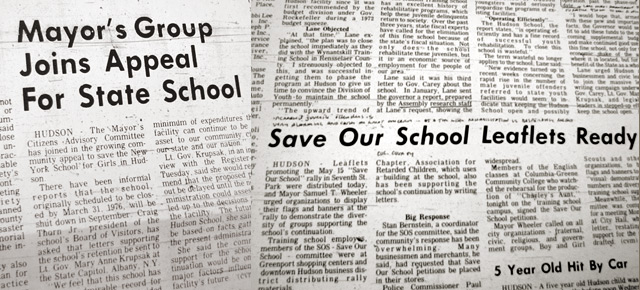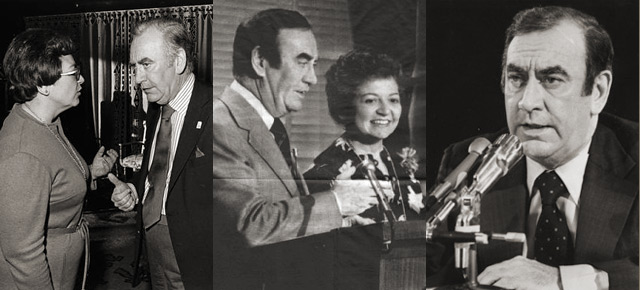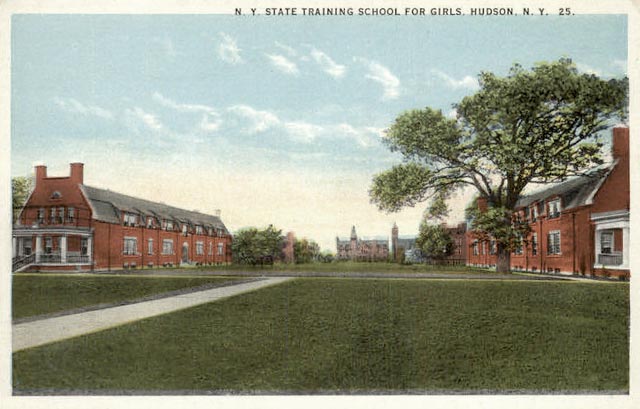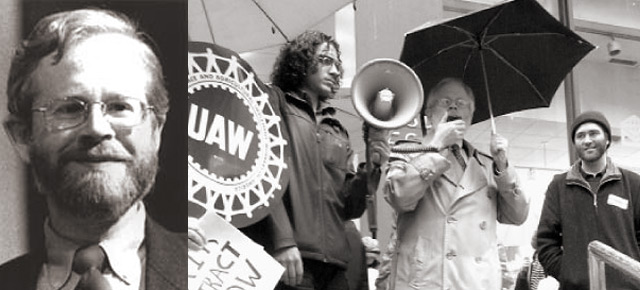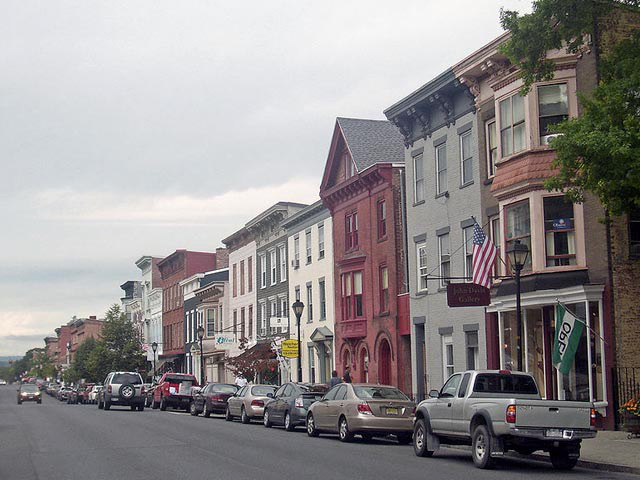a local perspective…
In the few months before its closing on August 18th, 1975, Hudson residents, Training School employees, and elected officials waged a campaign to stop the closure. The following account, written by Russ Immarigeon, is culled from newspaper articles that appeared between May and August 1975 in the local newspaper, The Register Star. (Microfiche collections of back issues of the newspaper are available at the Columbia-Greene Community College library and at the newspaper’s office in Hudson, NY.)
On May Day 1975, rumors were flying.
The New York State Training School For Girls (GTS) was scheduled to close its doors at the end of March 1976. Less than 12 months were left to organize if the facility was to remain open. Jobs were at risk. Local merchants were concerned about a loss of business. Adding to general worries, some people felt that the GTS would be boarded up as early as September, in only five months time.
Philip Pomeranz, Chairman of the Mayor’s Citizen Advisory Committee, fired an opening volley. In a telegram to Lt. Governor Mary Anne Krupsak, who showed solid support for the facility, Pomeranz said, “We feel this school has an admirable record for rehabilitating our misguided youth. And with a minimum of expenditures this facility can continue to be an asset to our community, city, state, and nation.” (Register Star, “Mayors Group Joins Appeal for State School,” p. 1)
A letter writing campaign ensued. Through a Save Our School (SOS) committee, employees of the GTS gathered 300 letters of support from merchants and residents at a local shopping center. The Hudson Lion’s Club beseeched that the school’s closing would be a “critical economic disaster.” Folks from the Home for the Aged stuffed envelopes.
A week later, the Register Star reported that “school employees in cooperation with local banks will cash their paychecks in silver dollars and new currency, which will be marked in sequence so it can be traced to the school’s payroll.” (RS, “Training School Workers Plan Silver Dollar Day,” May 6, 1975, pp. A-1, A-2)
Only two years after the Attica prison rebellion in western New York, SOS coordinator Marty Gallanter told state leaders — not only Lt. Governor Krupsak, but also representatives of the NYS Division of the Budget, the NYS Assembly Ways & Means Committee, and the NYS Senate Finance Committee – of Hudson resident’s “beautiful and unusual attitude.”
“The Hudson community is unique in its interest in the state institution. Most communities resist schools of this type and desire their rapid removal every time the problems of the school reach the community. This city has seen us through the most troublesome summer in the history of the training school, and the people still stand behind us with their support for our continuation.” (RS, “Official Letter Slated for School,” May 7, 1975, pp. A-1, A-2)
Local politicians joined the fray.
Noting that the nearby Wynantskill Training School had already closed, Assemblyman Clarence D. Lane wrote, in one of several letters to Gov. Hugh Carey highlighting the GTS’s economic and social service value, “The Hudson training school has an excellent history of rehabilitation programs, which help these juvenile delinquents return to society. Over the past three years, state fiscal experts have called for the elimination of this fine school because of the state fiscal situation. Not only does the school rehabilitate these juveniles, but it’s an economic source of employment for people in our area.”
Assemblyman Lane also cautioned about rising levels of delinquency. “Some or all of the beds at Hudson may need to be converted to accommodate the backlog of male juvenile delinquents,” he told the Governor. “The upward trend of increased juvenile offenders is very alarming and causes me great concern that the state is closing the Hudson Training School at a time when rehabilitation for youthful offenders is desperately needed.” (RS, “Rise in Referrals Shows Need for School: Lane,” May 8, 1975, pp. A-1, A-2)
Lane’s missives came only a few months after a January 1975 Assembly research report concluded that the buildings at the Hudson Training School were good, all beds were filled, more beds would be needed, the facility was operating efficiently, and any transfer of girls would jeopardize existing programs. In this context, he offered a supplemental budget amendment for $970,000 to keep the school open for the benefit of Hudson as well as the State.
Citizen rallies – and more letters — followed.
The Register Star urged fraternal, civic, religious, and governmental organizations “to bring their flags and banners to (a May 15) rally, a visual demonstration of the numbers and diversity of training school supporters.” Two thousand residents signed a letter and 20 organizations, ranging from the Society to Promote Our Unique Town (SPROUT) to the NAACP, sent a group letter to Lt. Gov. Krupsak supporting the GTS.
The Rev. Harold G. Nixon, who had been chaplain at the school for 17 years, wrote the Register Star, “It seems that the most important plus symbol for continuing the school would be the response of the hundreds of young people who now lead wholesome and decent lives – many who have positions of responsibility in the cities where they live – some as nurses and nurses aides, some as overseas telephone operators for the telephone companies. Many as good parents, etc. I am sure that the school has hundreds of letters from young people who found new hope and direction and rehabilitation there.” (RS, Letter to the Editor, May 8, 1975, p. B-2)
A 17-year-old girl, who had been at the school for 16 months, wrote a letter to the Register Star. “I am writing this,” she said,” with the hope that someone in the community will hear what I am saying and try to help. I feel it would be very wrong for this school to be closing down. We will be losing a lot of wonderful people who care. But also we’ll be losing the help that so many of us want and need.” (RS, May 14, 1975, “Girl Starts Letter Drive at Training School,” p. A-2)
On May 15, 1975, Silver Dollar Day found 125 GTS employees cashing their paychecks and attending a rally at the Seventh Street Park, where Father Ian and Caroline Mitchell sang folk songs.
Columbia County and Family Court judge Warren E. Zittell observed that he communicates with the Training School every month. “I have toured the grounds and buildings and although the physical plant is not as modern as some schools more recently constructed I am definitely of the opinion that the healthful environment and most important the accumulated wisdom, experience, and teamwork of the staff require that this institution continue to play a vital role in shaping the lives of its residents.” (RS, “Silver Dollar Day Starts for School,” May 15, 1975, A-2)
The Seventh Street Park rally was actually short of expectations, but 200-250 were reported in attendance. Moreover, Assemblyman Lane was optimistic about the school remaining open. Plus, former Superintendent Tunney had written Assemblyman Richard Gottfried, who chaired the Assembly’s committee on childcare. Assemblyman Gottfried visited the school and was enthusiastic.
In coming months, more letters were sent, more people signed their signatures approving the school, more trips were made to Albany, and Lt. Gov. Krupsak, stressing that she would conduct an “extensive survey of the Hudson situation,” continued to show support for the school’s remaining open.
Several research studies – one from the new School of Criminal Justice at the University of Albany – supported the school’s programming and the community’s diverse support.
Rumors continued to fly.
Assemblyman Gottfried, who met with Patricia Lynch of the budget director’s office, said “No one is telling anyone what is going on.” He added that the school’s imminent closing was “unthought out” and “without rational planning.”
Budget director Peter Goldmark met with Assemblyman Gottfried and promised a study of operating costs. GTS staff and the state legislative research office started their own studies. (RS, “Training School Won’t Close July 1; Sept. 1 Plans ‘Not Specific,’” May 29, 1975, p. A-1)
In early June 1975, New York State officials proposed 100 new beds for GTS girls at Tryon and Highland Schools. The state still hoped to save $2 million.
Lt. Gov. Krupsak’s office started losing hope that the Division of the Budget would recommend keeping the school open for a string of reasons:
- The age of the facility;
- The cost of rehabilitating buildings;
- Overstaffing;
- Difficulties implementing modern programs with current staff;
- The inability to convert to a co-ed facility because of the high number of women employees;
- The high cost (approx. $22,000) of each resident’s care and custody; and
- Difficulties with the facility’s heating plant.
The Lt. Gov. recommended that funding be delayed for six months while an interdepartmental study assessed the situation.
One of the rumors flying, according to the Hudson Register Star, was that judges were reluctant to send girls to the school because of problems with homosexuality. “Homosexuality?,” exclaimed Superintendent George Dolecal. “We don’t have it.”
In mid-June, Lt. Gov. Krupsak made a one-hour visit to the school.
The Register Star reported, “The students told her they believed the Hudson program had helped them, and that it could help others. The girls displayed a marked respect for the school’s staff, which they conveyed to the Lt. Gov.”
Lt. Gov. Krupsak herself said, “An examination of the facts shows that not only should the Hudson School for Girls remain open, but that it should be used as a working model for community involvement in Division for Youth programs.”
Krupsak added, “The Hudson setting provides the girls with individual rooms, a setting that is more conducive to helping them solve their problems. This helpful atmosphere shows in studies by Marguerite Warren of the School of Criminal Justice at the State University at Albany. Those studies show that almost three of every four girls at Hudson feel the program there either helped or is helping solve their problems. The rate for those in other Division for Youth facilities hovers around 25 percent, according to the Warren study.”
“Here is an ideal opportunity,” she concluded, “not only to keep a worthwhile program operative, but also to use it as a working model in community participation, a key element in making any rehabilitation program a success. We must never lose sight of the fact that it is people not things which are of paramount importance.
A state Interdepartmental Committee on Youth was set up to reevaluate the Hudson situation.
GTS supporters in Hudson became increasingly disappointed as gradually government officials started thinking about “alternative uses” for the Hudson site. A spokesperson for the Lt. Gov. said, “We are not optimistic, but we are not giving up.”
In July 1975, the NYS Department of Corrections started feasibility studies on converting the facility to an academy for training correctional officers. Other possibilities included an industrial park and a housing estate.
By mid-August things were decidedly up in the air.
“At this time,” reported GTS Superintendent Dolecal, “it’s definitely indefinite. I don’t know what’s going to happen.” In all likelihood, he noted, the majority of the girls at the school would be sent home to New York City. Some would be sent to other facilities.
Democratic mayoral candidate Thomas Shriver told the Register Star that hopes for the school were like “a flickering candle.”
On August 13, 1975, on orders from the Division for Youth, the Hudson Training School for Girls started evacuating its residents. Girls started trickling out 2,3, or 4 a day. One-half of the girls were sent home as soon as their parents came to pick them up. The rest were sent to the Tryon and Highland institutions. Fewer girls were released to their homes than originally planned. “It’s a critical problem,” said Superintendant Dolecal, “Some parents don’t want the kids back, some can’t take them, and some kids don’t want to go back to their parents.”
On August 18, 1975, the New York State Training School for Girls at Hudson officially closed.

